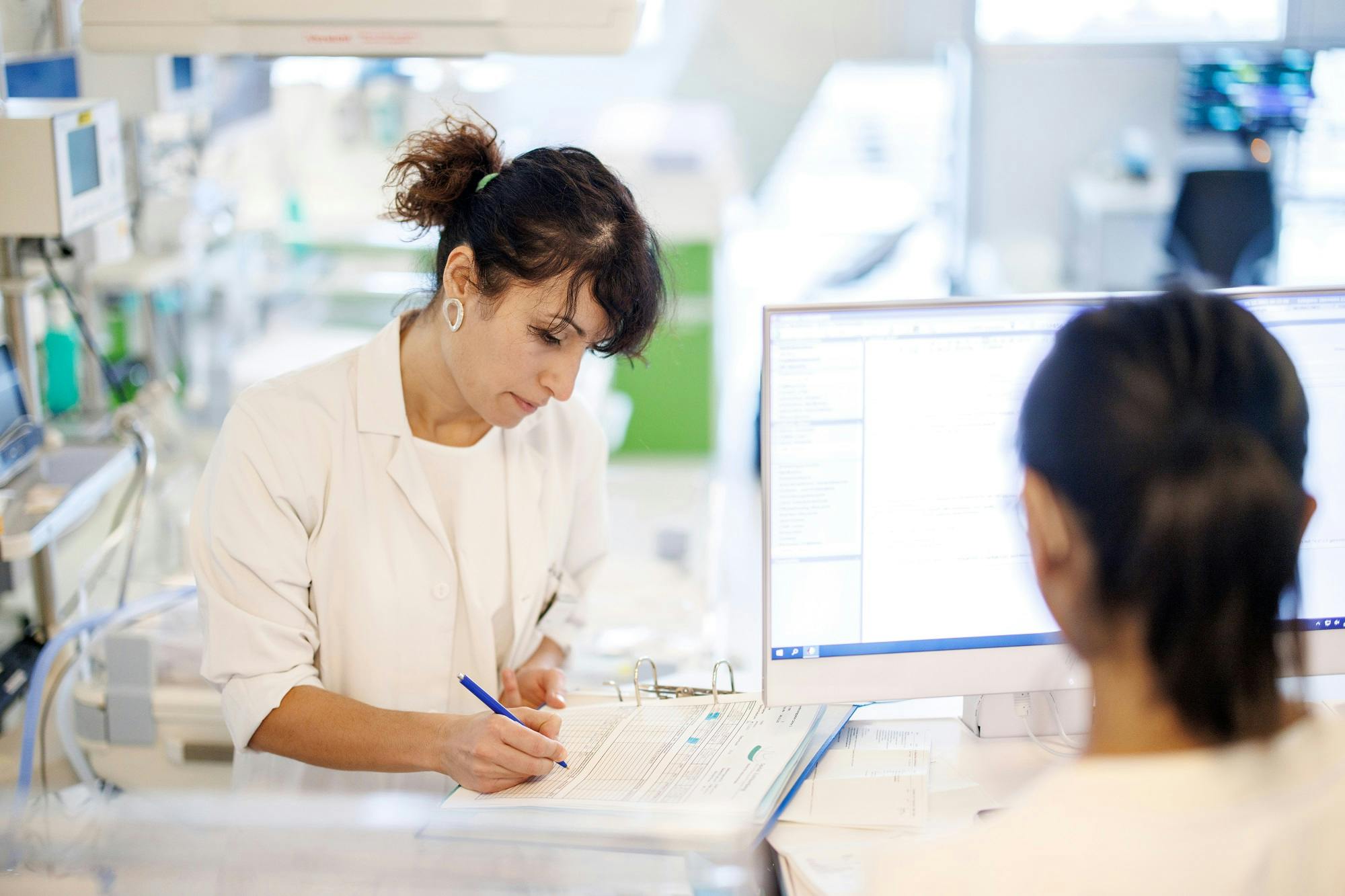Life after a heart attack: what happens next?
Dr. med. Sarah Spalinger
October 23, 2023
10 min
Dr Spalinger, how long do patients stay in hospital after a heart attack and how long do they have to stay in bed afterwards?
The length of hospitalisation can vary from patient to patient and depends on various factors: The severity of the heart attack, the type of medical interventions carried out and the individual recovery process. It should be noted that around 40 per cent of all patients who are diagnosed with narrowing of the heart vessels (coronary heart disease) do not suffer a heart attack at all. They usually present to the doctor with transient chest pain so that further investigations can be carried out in good time or, depending on the severity, hospitalisation can take place immediately.
At the other end of the scale, there are heart attacks (around 20 per cent of patients with coronary heart disease) that are accompanied by circulatory arrest. The typical scenario in the film: the patient clutches their chest, perhaps still talking about the pressure on their chest, or loses consciousness immediately. He has to be resuscitated and sometimes needs temporary intensive care support on the heart-lung machine.
However, the majority of heart attacks are much less spectacular. In this case, the patient is usually first admitted to the monitoring ward where, depending on the urgency, a cardiac catheterisation (coronary angiography) is performed immediately or within a few days, and the narrowed vessels can be treated directly with a balloon and stent. The patient is then transferred to the normal ward. If the procedure is uncomplicated, discharge is possible after just three to four days. If a bypass operation is necessary, the duration of hospitalisation is extended accordingly.
Bed rest is recommended before coronary angiography and is mandatory for up to six hours afterwards, provided that an approach from the groin (femoral) has been chosen, which is now rare. Depending on the severity of the heart attack, physical activity can then be increased quickly.
What rehabilitation options are available after a heart attack?
The choice between outpatient and inpatient rehabilitation after a heart attack depends on various factors, including the severity of the heart attack, but also on the patient's overall state of health and mobility. The majority of patients can take part in outpatient rehabilitation programmes. We also offer these programmes at Zollikerberg Hospital, which are very popular.
The outpatient cardiac rehabilitation programme lasts nine to twelve weeks and includes three training sessions with individually adapted intensity, each lasting just under an hour per week. Patients also attend a weekly lecture to learn more about heart-friendly nutrition, smoking cessation, diabetes counselling, stress management and relaxation, as well as psychocardiological support if required. For the rest of the week, patients can increasingly participate in normal everyday life again according to their abilities.
Inpatient rehabilitation takes place in specialised inpatient facilities.
Can patients recover completely or are they "heart sick" forever?
That depends on how much of the heart muscle was damaged by the heart attack. The proportion of scarred muscle (myocardium) in turn depends on the size of the coronary vessel that was blocked by the heart attack, on the existing bypass circuits in the heart and on the time it takes for sufficient blood to flow through the vessel again. That's why it's not called "time is muscle" for nothing. This means that the faster a coronary vessel that is completely blocked is reopened, the less damage the heart suffers. A distinction must be made here between heart attacks that are based on a complete blockage of the vessel and require rapid revascularisation, and those that are less urgent. As a general rule, it is important to consult a doctor as soon as possible if chest pain persists.
Nowadays, we can recognise a heart attack at a very early stage using highly sensitive laboratory values, so that in many cases no consequential damage remains. After treatment of the narrowed coronary vessels, the quality of life is sometimes even better than before, as the blood supply to the heart is now guaranteed again. Such patients feel symptom-free in everyday life and can carry out all activities without restriction.
Large heart attacks, on the other hand, can lead to cardiac insufficiency and arrhythmia. With optimal medical aftercare, however, a good quality of life can also be achieved here.
0/0
What are typical life changes or restrictions after a heart attack?
A heart attack is often perceived as a "shot across the bow". An opportunity to get your health back on the right track. And I have seen amazing changes in the process. There are patients who completely change their lives: they start a regular sports programme, eat healthily, stop smoking, lose weight, reduce stress and thus significantly improve their blood values and well-being. It is as if they have been given a second chance at life, which they know how to make the most of.
Other patients only manage this lifestyle change to a limited extent. Smoking for years often cannot be given up, even though it would offer the greatest risk reduction. Where diet and exercise only help to a limited extent, however, is with cholesterol levels. Genetic predisposition is the main factor here. This is why cholesterol-lowering drugs, for which there is now a wide range of well-tolerated substances, are essential to minimise the risk of recurrent heart attacks. In addition, patients are given antiplatelet drugs (e.g. aspirin) and, after a stent insertion, a second antiplatelet drug temporarily to minimise the risk of the vessel re-closing. This may cause bleeding, although this is usually minor (e.g. skin haemorrhages). Temporary restrictions on the ability to drive are rarely necessary.
How likely is it that those affected will suffer a second heart attack?
There are various data on this, depending on the study population. The probability of a second heart attack varies from person to person, depending on how well the above-mentioned measures are implemented or how strong the genetic burden is. The risk of a second heart attack is highest in the first year, but remains elevated thereafter compared to the normal population.
0/0
Does a heart attack affect a person's life expectancy?
Life expectancy after a heart attack can vary greatly from case to case, depending on the severity of the heart attack, complications, medical care, aftercare and lifestyle. Studies have shown that the life expectancy of people over the age of 65 who have had a heart attack can be reduced by up to ten years on average. There is a risk of fatal cardiac arrhythmia if there is extensive scarring. For this reason, defibrillators (pacemakers with a defibrillation function) are installed in vulnerable people.
And how does a heart attack affect the psyche?
The heart is a central organ in the body. It keeps you alive, it is the place of longing, it is associated with love. If the patient only receives the information that the heart may have been damaged, this influences their perception of their own integrity. It's unsettling, and that's normal. As a young junior doctor, I once had to tell a patient who was calmly smoking outside that we had diagnosed a heart attack. He almost swallowed the cigarette in shock.
Not only in the acute setting, but also in the months afterwards, uncertainty can soften the filter that everyone has for self-recognising symptoms. For example, patients often report repeated chest complaints after a heart attack without an organic correlate being found. Some patients take it easy on themselves physically, partly out of fear, even though the heart is a muscle that needs training. However, this increased alert threshold is normal. The body and mind must first regain confidence in their own ability to perform. The good news is that confidence almost always returns. It just takes some time and "good-hearted" care and support.
0/0
Weitere Beiträge
Counsellor
Understanding panic attacks: What triggers them and how to counter them
Panic attacks are like sudden storms in the soul - they strike unexpectedly, unleashing a wave of intense fear and often leaving confusion and uncertainty in their wake. But what exactly is a panic attack, how are they diagnosed and treated, and what can sufferers do to deal with them? To delve deeper into this topic, we spoke to Dr Ruedi Schweizer, Medical Director of our Centre for Mental Health.
Counsellor
Can psycho-oncological support improve the chances of recovery or the quality of life of breast cancer patients?
In psycho-oncological topics, you and your relatives will be accompanied through all phases of the illness by experienced psychologists specialising in psychotherapy and specialists in psychiatry and psychotherapy. In this way, we can provide relief, give courage and open up new perspectives. Dr Ruedi Schweizer, our expert in psycho-oncology and Medical Director of the Centre for Mental Health, explains in the following video.
Counsellor
Focus on women's health: An interview with Dr Julia Graf, specialist in gynaecology and obstetrics
On International Women's Day, we would like to focus on women's health. To this end, we met with Dr Julia Graf, an experienced specialist in gynaecology and obstetrics and senior physician at the Women's Clinic, to talk about various aspects of women's health.


